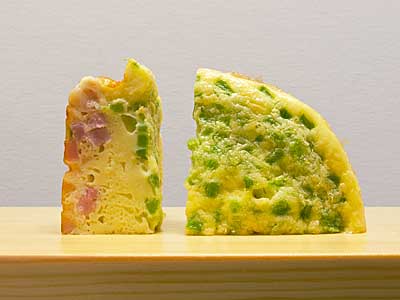August 27, 2012
Amuse-Bouche

omelette Denver
(Denver omelet)
Cafés and coffee shops went through a culinary revolution late in the 1960s and into the 1970s. When you ordered breakfast, the selection of bread changed from white, wheat, or rye sandwich bread to house-made muffins, country-style breads, and bagels. Hash browns learned to share a new list of choices with home fries and various roast potatoes. Scrambled eggs now came with various fillings and toppings, although you could still order them plain. Fried eggs were still available sunny side up, over easy, or hard. A “new” addition to the menu was an omelet where the diner could select the fillings from a seemingly endless list of possibilities. It wasn’t that that omelets were a new dish, it was the wider freedom of filling selection that was new.
The concept of cooking beaten eggs with one or more flavorings or fillings is quite old, and many national forms have evolved over the millenniums. The Spanish tortilla, Italian frittata, and the French baked, flat omelet all evolved from a common source. Early omelets also shared some roots with modern crepes.
Prior to the post-hippie breakfast revolution, the omelet available to the average customer was a plain one or a Denver—sometimes called western—omelet. The plain omelet was an alternative means of ordering dry scrambled eggs. Most restaurants selling breakfast depended on a flattop grill for much of their short-order cooking. Beaten eggs poured onto the grill would spread into a thin, flat circle. If the cook chopped the cooking eggs with the edge of his spatula, they would be scrambled. If the cook just used his spatula to fold or roll the cooked eggs, an omelet would be served. If a Denver omelet was the order, then a few pieces of diced ham, green bell pepper, and cheese would be folded into the omelet.
My memory of the Denver omelets of that period was that they usually were quite dry. The peppers were raw in both texture and taste. The ham was usually what was sold in those days as boiled ham, a product made from cured pork pressed into a long, square loaf so it could be sliced on an electric meat slicer. The cheese would usually be processed American cheese. The Denver omelet was more exciting than plain scrambled eggs—what my mother usually ordered for me when I was young—but the excitement was limited. Once I let my hair grow out, smoked some weed, and departed the old homestead, I replaced my limited Denver-omelet experience with an abundance of post-hippie omelets filled with spinach, ham, and cream cheese.
When I started to think about a riff on that classic Denver omelet, I had to refresh my memory of what those omelets from the 1950s were like. I remembered the rawness of the peppers, but not much else. A little time on the Internet dusted the cobwebs from the necessary parts of my mind.
I tried making a few rolled varieties, but in the small size I desired for an amuse-bouche, the assemblies quickly disassembled. So I opted for a flat, French omelet in shape.
1 extra-large
egg
1 T
heavy cream
fine salt
freshly ground black pepper
1 large
green jalapeño pepper, cored, seeded, peeled, 3-mm (1⁄8-in) dice
ham, quantity to match green pepper, 3-mm (1⁄8-in) dice
raclette, quantity to match green pepper, 3-mm (1⁄8-in) dice
1. Preheat oven to 180 °C (355 °F). Prepare a 10-cm (4-in) round, nonstick tart pan with butter or baking spray.
2. Beat the egg with a fork until frothy. Beat in the cream, salt, and black pepper. Add the green pepper, ham, and cheese. Stir to mix. Pour the mixture into the prepared pan.
3. Bake until the egg is firm, about 15 minutes.
4. Set the pan aside to rest until the omelet has mostly deflated to its original size.
5. Remove the omelet from the tart pan, and cut it into wedges for serving.
Yield: 4 servings.
© 2012 Peter Hertzmann. All rights reserved.
